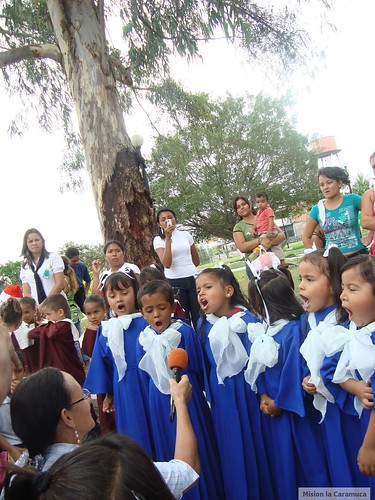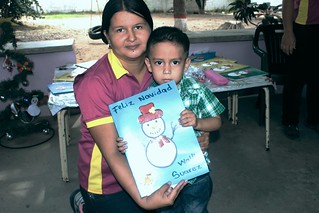"For behold, darkness shall cover the earth, and thick darkness the peoples; but the LORD will arise upon you, and his glory will be seen upon you. And nations shall come to your light, and kings to the brightness of your rising." (ESV)
While I read from Isaiah 60:2-3, José Ignacio Garrido lit the first candle in our Advent wreath on November 29, the first Sunday in Advent 2015. The words are addressed to the people of God, who were the children of Israel in Isaiah's day, but now the verses speakto the Church of the New Testament. They announce the opening of the Messianic period. In Jesus the glory of the Lord has arisen upon the Church, like the sun in all its splendor and majesty. While the earth as a whole still is covered by the darkness of sin and iniquity, the light of Christ upon the Church, which shone upon those who awaited the Messiah, arose and shone during all the long centuries since the Gospel first was proclaimed. This light will shine through the Church into the darkness and draw the nations to it, as light of a heavenly chorus drew the shepherds and later the miraculous star drew the Magi to Bethlehem.
This is the first years that we have used an Advent wreath during this season in our worship at Epiphany Lutheran Mission of La Caramuca. The candlestand was built by ironworker Ciro Mendoza, and was decorated by Luz Maria and her daughter, Angi Santana. As I explained, the circle of candles appears to be adorned with pine branches, but the spines really represent the crown of thorns on the Lord's head as He made His journey to the cross for us.
That is why our first Gospel reading for Advent was Matthew 21:1-9. This is Matthew's account of the Lord's last entry into Jerusalem on Palm Sunday. We remember it as we begin our preparation for the celebration of His birth, because His Incarnation also was a joyous entry into this world, at which time He was hailed and adored. But it also was the beginning of His road to the cross, because He was born into this world to suffer and die for us.
We closed the old church year amid news of disasters, terrorist attacks, an international refugee crisis and the possibility of another global war. There were Venezuelans who, with people of other nations, died in the terrorist actions in Paris and Mali. Closer to home, starting on November 7, the neighboring state of Mérida, Venezuela, was struck with a series of earthquakes measuring as high as 5.3 in magnitude, and resulting in death, injuries and damages to homes and public buildings. Our preschool, as well as other schools, was ordered to close early for the year, as critical national elections have been scheduled for December 6. Many hope these elections will bring about changes in a country that has for years been plagued by runaway inflation, shortages of foodstuffs and medicines, and one of the world's highest rates of violent crime. Unfortunately, fears for public safety during this politically tense period proved valid as one candidate, Luis Manuel Diaz, was assassinated on the campaign trail.
Of course, the Scripture readings for the last three Sundays of the church year deal with the end times, the trials to come and the ultimate victory of Christ. We have been able to take comfort in such passages as Matthew 24:6-13, "And you will hear of wars and rumors of wars. See that you dare not be alarmed, for this must take place, but the end is not yet. For nation will rise against nation, and kingdom against kingdom, and there will be famines and earthquakes in various places. All these are but the beginning of the birth pains.
“Then they will deliver you up to tribulation and put you to death, and you will be hated by all nations for my name's sake. And then many will fall away and betray one another and hate one another. And many false prophets will arise and lead many astray. And because lawlessness will be increased, the love of many will grow cold. But the one who endures to the end will be saved. And this gospel of the kingdom will be proclaimed throughout the whole world as a testimony to all nations, and then the end will come." (ESV)
Due to the early closing of the preschool, we held a Christmas party for the children and their parents on November 26, as we may not see some of them again until January. All the children received presents and they sang their favorite Christmas songs, such as "Campanas Por Doquier" which sound like "Jingle Bells", but really is about the Nativity). On November 18, the preschool children exchanged Christmas greetings with the preschoolers of St. Michael's Lutheran Church, Bloomington, Minnesota, by way of an Internet videoconference. We only recently have had the bandwidth to try something like that.
We ask you to remember Venezuela in your prayers in the days to come, and especially to ask for a peaceful solution to the country's problems and a brighter future in 2016.
El Amor de Dios/Campanas Por Doquier from David Ernst on Vimeo.
Showing posts with label Navidad. Show all posts
Showing posts with label Navidad. Show all posts
Nov 30, 2015
Dec 7, 2010
Children win caroling contest
 A group of our older preschool children placed first in a Christmas carol-singing contest in the town square November 30, 2010. The group, which we called "Niños Cantores" (Singing Children) competed against similar groups from all the other preschools in our area. Niños Cantores included:
A group of our older preschool children placed first in a Christmas carol-singing contest in the town square November 30, 2010. The group, which we called "Niños Cantores" (Singing Children) competed against similar groups from all the other preschools in our area. Niños Cantores included:- Karla Altuve
- Brayan Arteaga
- Geiver Cordero
- Sugleisbeth Pérez
- Marlenis Piñero
- María Ruiz
- Solisbeth Sanchez
- Lorianny Vivas
In fact, Spanish versions of some carols familiar to North Americans are popular in Venezuela. One example would be "Noche de Paz" ("Silent Night" in English or "Stille Nacht" in the original German). There also is a song sung in Venezuela to the tune of "Jingle Bells," but intead of "dashing through the snow in a one-horse open sleigh", the lyrics speak of Christ's birth and the joy of Christmastide.
However, many villancicos are written in colloquial Spanish and allude to things specific to their country of origin, even a particular region within that country. That can make them difficult to translate into English. Such is the case with "El Niño Jesús Llanero," a song that our preschool children were assigned to sing.
"El Niño Jesús Llanero" is actually a modern villancico, written by Simon Diaz, a Venezuelan folk singer and entertainer who still is very much alive. Born August 8, 1928, in Barbacoas, Venezuela, he is known throughout the country as "Tio Simon" (Uncle Simon), because of his long-running children's television program, "Contesta por Tio Simon". Indeed, over the years Simon Diaz has hosted many different radio and television programs, appeared in films and stage plays, and recorded more than 70 musical albums. His works have been performed by artists such as Placido Domingo, Ray Conniff, Julio Iglesias and Ruben Blades. In 2008, Simon Diaz received the the Latin Recording Academy Trustees Award in Houston, Texas.
Despite Diaz's international reputation, however, the focus of his life's work has been to preserve and renew the culture of Venezuela, especially that of los Llanos, the Venezuelan plains region. So it is with "El Niño Jesús Llanero." In keeping with the Savior's humble origin, the song paints a poetic portrait of the Christ Child as an Indian boy of the prairie, clad in sandals (although sandals of gold) and a white hat, with a spinning top in his hand as is typical of such boys.
The following is the chorus and first verse of the song, with my attempt at English translation:
En mi conuquito
Las flores del campo
adornan su belleza
y brille su splendor
Niñito llanero, indio soberano
dámele cariño, dámele ternura
al venezolano
In my garden, the wildflowers
adorn your beauty and shine with your splendor
Little prairie boy, Lord of Indians
Show affection and tenderness to Venezuela
The second song was to be a traditional carol of our own choosing, which was "Cantemos, cantemos." This one is much easier to translate:
Cantemos, cantemos, gloria al Salvador
Feliz nochebuena, feliz nochebuena
con el Niño Dios
Tu eres la esperanza, Tu la caridad, Tu eres el consuelo de humanidad.
Let us sing, let us sing, glory to the Savior
Happy Christmas Eve, Happy Christmas Eve
with the Christ Child
You are the hope, you are the charity, you are the consolation of mankind.
The third song was to be an original, unpublished composition. Luz Maria wrote this one:
Repiquen los tambores, suenen las maracas
nosotros cantamos, nosotros cantamos
si nos dan hallacas
Alegres cantamos en este parrandón
saberes y sabores, saberes y sabores
con el Niño Dios
A nuestras maestras, las gracias les damos
y a los que no escuchan, a los que no escuchan
dame mi aguinaldo
Que no sean pichirres, que no sean pichirres
nosotros no vamos
Beating drums, maracas sounding
we will sing, we will sing
if you give us hallacas
Let us sing joyfully at this festival
of crafts and cooking, of crafts and cooking
with the Christ Child
To our teachers, we give thanks
and to those who will listen, who will listen
(we say) Give me my Christmas treat
To those who are cheapskates, to those who are cheapskates
we will not go
The hallaca is the traditional Venezuelan Christmas tamale.
Subscribe to:
Comments (Atom)


